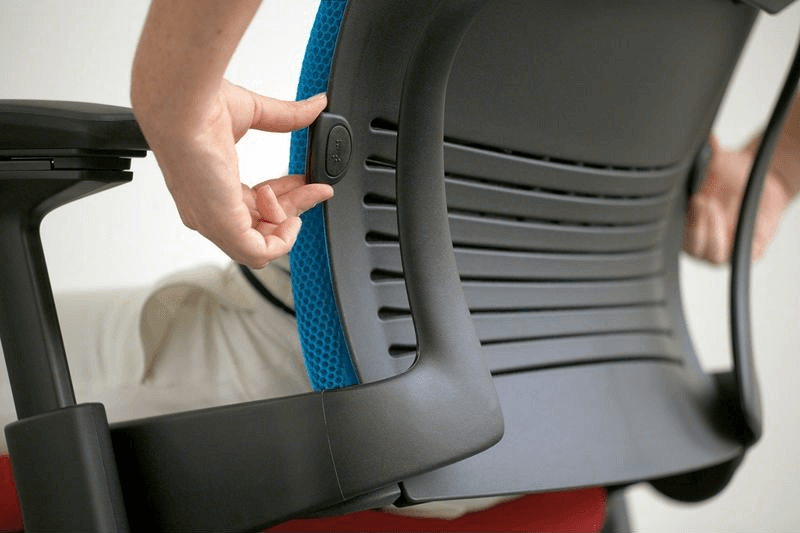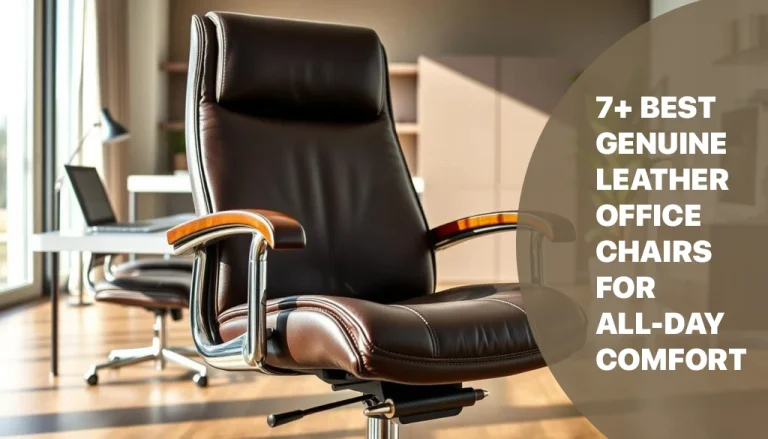How to make office chair more comfortable? Working long hours in an uncomfortable office chair can affect productivity and well-being.
However, with a few adjustments and additions, you can transform your chair into a comfortable and supportive one that promotes better posture, reduces strain, and enhances your overall work experience.
1. Adjust The Chair Height
Chair height is crucial for optimal comfort. Sitting flat on the ground helps maintain proper posture and alleviates pressure on your lower back.
Additionally, you can adjust your seat height so that your feet rest comfortably on the floor and your knees form a 90-degree angle. If the seat is too high, consider using a footrest to support your feet adequately.

2. Set A Backrest Angle
The angle of your chair’s backrest, especially when considering office chairs for a bad back, is essential to your relaxation. Maintaining an upright posture for extended periods can strain your spine and cause discomfort.
To support the natural curve of your back, it’s recommended to tilt the backrest slightly backward. An angle of 100 to 110 degrees is optimal. Moreover, avoid sitting entirely upright at a 90-degree angle, as it can put undue stress on your spine, leading to aches and pains.
Finally, find a relaxed position by adjusting the backrest angle to support your lower back adequately.
3. Use Lumbar Support
The lumbar support of your furniture is the area that assists your lower back. For the chairs without adequate lumbar support, you can use a cushion or a rolled-up towel to support your lower back—this helps maintain the natural curve of your spine and reduces the strain on the position.
You can also invest in a chair with adjustable lumbar support to help reduce the pressure on your body part.
Read more: How To Adjust An Office Chair
4. Cushion The Seat
Prolonged sitting can lead to discomfort and pressure on the buttocks and thighs. One effective solution is to use a cushioned seat that helps distribute your weight evenly, alleviating stress in these areas.
Consider adding a cushion or seat pad to your chair, providing extra padding and reducing the strain on your buttocks and thighs. This simple addition can significantly enhance your comfort during extended periods of sitting.
5. Position Armrests Correctly
Spending too much time resting your elbows on the armrests might cause discomfort and agony. Therefore, your chair’s armrests should be positioned and adjusted for height and angle to your preference.
Remember, when your arms are supported, your shoulders, neck, and upper back will experience less stress.
6. Utilize Ergonomic Accessories
There are several ergonomic accessories available to enhance your posture and reduce strain on your body, for example:
- Elevating your feet with a footrest alleviates pressure on your lower back while sitting. By providing support and proper alignment, a footrest can help improve your overall comfort and posture.
- Using a keyboard tray is highly beneficial to reduce strain on your wrists and forearms. It ensures that your wrists are in a neutral position, minimizing the risk of discomfort or repetitive strain injuries.
- Positioning your screen at the correct height is crucial for reducing strain on your neck and shoulders. A monitor stand can help elevate your monitor to the appropriate level, aligning it with your eye level. This promotes a more ergonomic viewing angle and helps prevent unnecessary strain on your neck and shoulders.
7. Practicality Over Style
While stylish office chairs may be visually appealing, they sometimes prioritize comfort. When choosing an office chair, it’s important to prioritize comfort and support over aesthetics.
Opt for a chair specifically designed for comfort, with adjustable features such as height, backrest, and armrests. You can customize the furniture to fit your body’s unique needs.
Remember, it’s crucial to prioritize your comfort when selecting an office chair rather than solely focusing on style.
Read more: How To Make Office Chair Lean Back
8. Adjust Your Working Space
Creating a comfortable and ergonomic working space is crucial to prevent strain on your body while sitting in your chair. Consider the following tips:
- Desk height: Set your desk at a height that allows your arms to rest comfortably at a 90-degree angle while using or typing the computer. Avoid putting your workstation too high or too low, as this can strain your wrists and arms.
- Keyboard and mouse position: Place your keyboard and mouse so your wrists are straight and relaxed. Bending your wrists upward or downward might cause pain and repetitive strain injuries.
- Screen height: Adjust the screen or use a monitor stand to achieve the correct size and avoid looking downward or upward for extended periods.
- Document holder: If you frequently refer to documents or papers while working, use a document holder to keep them at eye level. This helps maintain proper alignment and prevents strain on your neck and shoulders.
Investing in suitable office chairs for a bad back can also make a significant difference in your comfort and overall well-being while working long hours at your desk.

Conclusion
How to make office chair more comfortable? Investing time and effort into making your office chair more comfortable is a worthwhile endeavor that can significantly impact your work performance and overall well-being.
With appropriate ergonomic adjustments, adding supportive accessories and paying attention to your posture can alleviate discomfort and create an environment that encourages productivity and creativity.
FAQ





